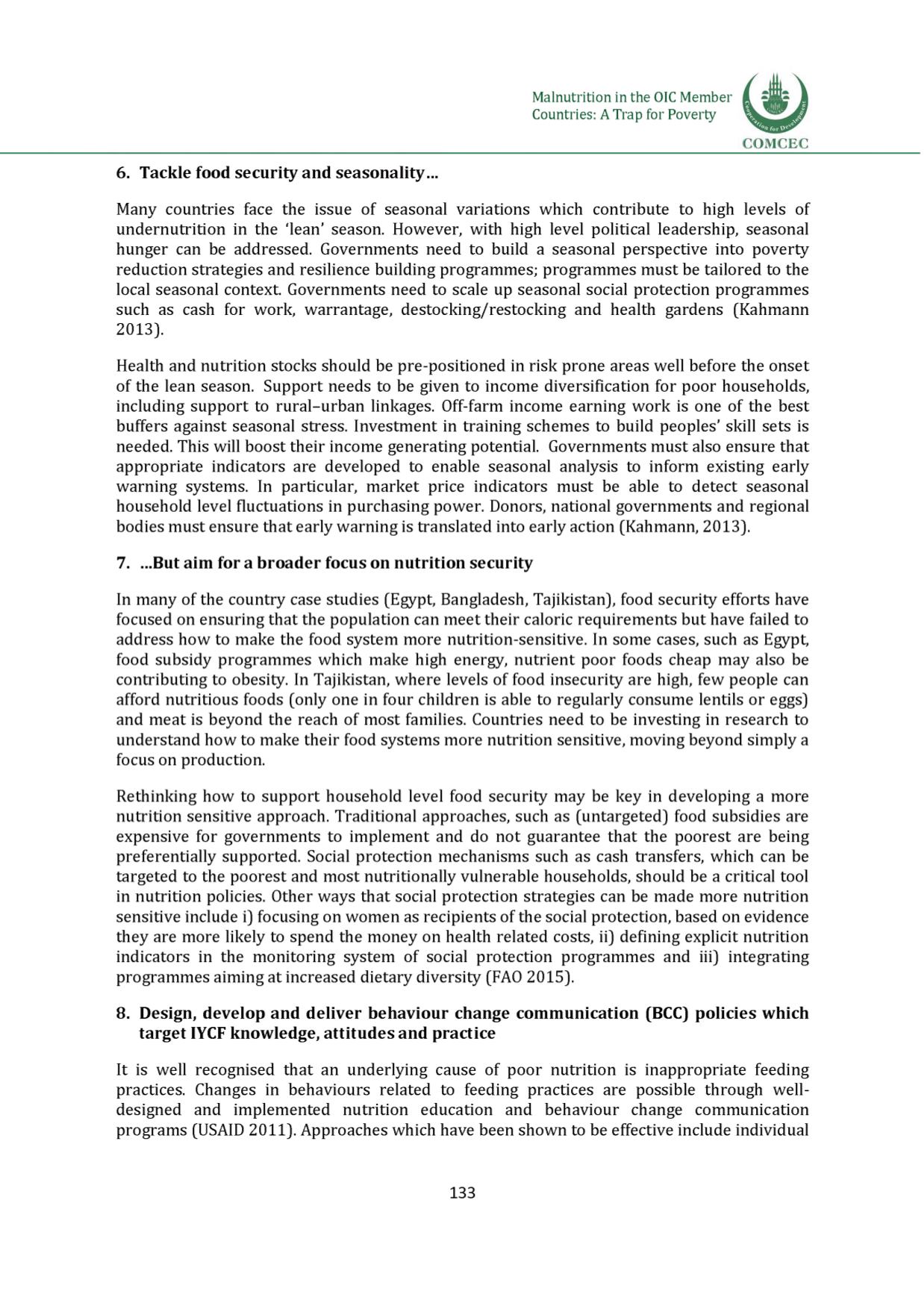

Malnutrition in the OIC Member
Countries: A Trap for Poverty
6. Tackle food security and seasonality...
Many countries face the issue of seasonal variations which contribute to high levels of
undernutrition in the 'lean' season. However, with high level political leadership, seasonal
hunger can be addressed. Governments need to build a seasonal perspective into poverty
reduction strategies and resilience building programmes; programmes must be tailored to the
local seasonal context. Governments need to scale up seasonal social protection programmes
such as cash for work, warrantage, destocking/restocking and health gardens (Kahmann
2013).
Health and nutrition stocks should be pre-positioned in risk prone areas well before the onset
of the lean season. Support needs to be given to income diversification for poor households,
including support to rural-urban linkages. Off-farm income earning work is one of the best
buffers against seasonal stress. Investment in training schemes to build peoples' skill sets is
needed. This will boost their income generating potential. Governments must also ensure that
appropriate indicators are developed to enable seasonal analysis to inform existing early
warning systems. In particular, market price indicators must be able to detect seasonal
household level fluctuations in purchasing power. Donors, national governments and regional
bodies must ensure that early warning is translated into early action (Kahmann, 2013).
7. .B u t aim for a broader focus on nutrition security
In many of the country case studies (Egypt, Bangladesh, Tajikistan), food security efforts have
focused on ensuring that the population can meet their caloric requirements but have failed to
address how to make the food system more nutrition-sensitive. In some cases, such as Egypt,
food subsidy programmes which make high energy, nutrient poor foods cheap may also be
contributing to obesity. In Tajikistan, where levels of food insecurity are high, few people can
afford nutritious foods (only one in four children is able to regularly consume lentils or eggs)
and meat is beyond the reach of most families. Countries need to be investing in research to
understand how to make their food systems more nutrition sensitive, moving beyond simply a
focus on production.
Rethinking how to support household level food security may be key in developing a more
nutrition sensitive approach. Traditional approaches, such as (untargeted) food subsidies are
expensive for governments to implement and do not guarantee that the poorest are being
preferentially supported. Social protection mechanisms such as cash transfers, which can be
targeted to the poorest and most nutritionally vulnerable households, should be a critical tool
in nutrition policies. Other ways that social protection strategies can be made more nutrition
sensitive include i) focusing on women as recipients of the social protection, based on evidence
they are more likely to spend the money on health related costs, ii) defining explicit nutrition
indicators in the monitoring system of social protection programmes and iii) integrating
programmes aiming at increased dietary diversity (FAO 2015).
8. Design, develop and deliver behaviour change communication (BCC) policies which
target IYCF knowledge, attitudes and practice
It is well recognised that an underlying cause of poor nutrition is inappropriate feeding
practices. Changes in behaviours related to feeding practices are possible through well-
designed and implemented nutrition education and behaviour change communication
programs (USAID 2011). Approaches which have been shown to be effective include individual
133
















